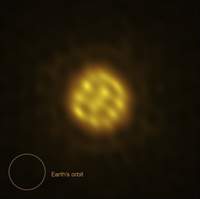Science Highlight
The hot bubbling surface of R Doradus
In a paper recently published in Nature, Wouter Vlemmings and colleagues present a series of reconstructed interferometric images (one of which is shown here) of the surface of the evolved giant star R Doradus, which reveal a stellar disc with prominent small scale features that provide the structure and motions of convection on the stellar surface. The dominant structure size of the features on the stellar disc is found to be 0.72 ± 0.05 astronomical units. The velocity of the surface motions varies between −18 and +20 km/s , which means the convective timescale is approximately one month. This indicates a possible difference between the convection properties of low-mass and high-mass evolved stars.

